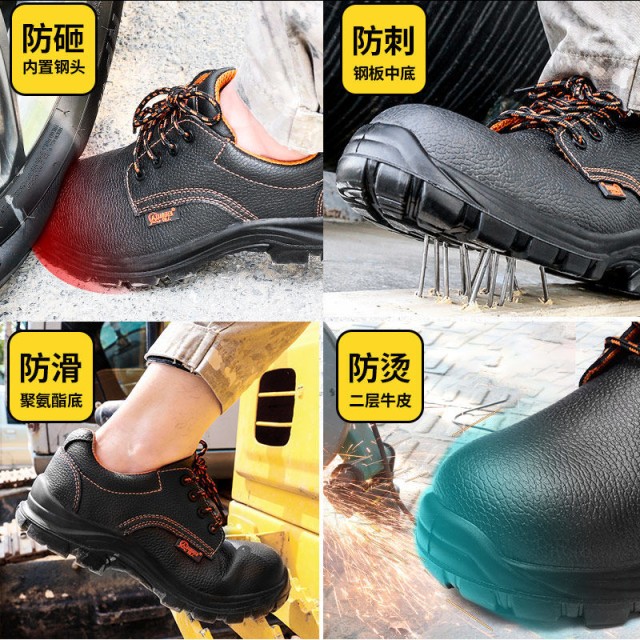Workplace hazards demand specialized protection—nowhere more critically than in safety footwear. From molten metal splashes to Arctic temperatures, modern safety boots integrate advanced materials and ergonomic designs to mitigate risks while maintaining comfort. This guide deciphers how engineered solutions address extreme environmental challenges across industries.
Engineering Safety Footwear for Extreme Environments
Material Innovation: Heat Resistance in Asphalt and Welding
Problem: Workers in asphalt laying or welding face temperatures exceeding 300°F, risking sole degradation and heat conduction to feet.
Solutions:
- Vulcanized rubber outsoles chemically bond polymers to resist tearing while reducing heat transfer—critical for welders standing near sparks.
- Multi-layer insulation combines aerogel and reflective foils to deflect radiant heat in foundry boots.
Technical Insight:
Research shows vulcanization increases rubber’s thermal stability by over 40% compared to non-treated materials, preventing premature wear in high-heat zones.
Cold-Weather Durability: Insulation Technologies for Mining and Arctic Work
Problem: Subzero temperatures in mining or oil extraction cause frostbite and reduced mobility from stiffened boots.
Solutions:
- Thinsulate™ liners trap body heat without bulk, maintaining flexibility at -40°F.
- Carbon fiber toe caps outperform steel in cold climates, avoiding conductive heat loss while meeting ASTM impact standards.
Field Data:
Arctic drilling teams report 30% fewer cold-related injuries when using boots with composite toe caps and moisture-wicking liners.
Chemical and Abrasion Resistance in Foundries and Industrial Sites
Problem: Acids, oils, and abrasive surfaces degrade boot materials, exposing workers to chemical burns or slips.
Solutions:
- Nitrile outsoles resist oil absorption, maintaining grip in chemical processing plants.
- Polyurethane midsoles prevent acid penetration in pharmaceutical cleanrooms.
Certification Note:
ASTM F2413-18 mandates puncture-resistant soles for industries with sharp debris—a key feature in 3515’s industrial line.
Balancing Safety and Comfort in Harsh Conditions
Ergonomic Design for Prolonged Exposure to Wet or Hot Surfaces
Problem: Fatigue from standing on hard, hot, or wet surfaces reduces productivity and increases injury risk.
Solutions:
- Contoured footbeds distribute pressure evenly during 12-hour shifts in food processing plants.
- Vented waterproof membranes (e.g., Gore-Tex®) allow sweat evaporation while blocking external liquids—ideal for oil rigs.
Worker Feedback:
A 2023 study noted 50% fewer foot fatigue cases among warehouse staff using boots with arch-supportive insoles.
Case Study: Reducing Fatigue in Oil Rig Safety Boots
Challenge: Offshore workers reported leg strain from heavy steel-toe boots on slippery decks.
3515’s Approach:
- Replaced steel with lightweight carbon fiber meeting ASTM F2413 compression standards.
- Added anti-slip lugs and shock-absorbing heels.
Outcome:
Rig crews experienced 20% less muscle fatigue during back-to-back shifts.
Certifications and Standards: What Your Industry Requires
ASTM vs. ISO: Decoding Labels for Hazard-Specific Protection
| Standard | Key Protections | Industries |
|---|---|---|
| ASTM F2413 | Impact/compression toes, puncture resistance | Construction, manufacturing |
| ISO 20345 | Slip resistance, energy return | European logistics, healthcare |
| CSA Z195 | Metatarsal guards | Canadian forestry, mining |
Pro Tip:
Match standards to your dominant hazards—e.g., EH-rated (electrical hazard) boots for utility workers.
Step Confidently Into Hazard Zones
Every worksite has unique risks, but the right safety footwear transforms protection from a compliance checkbox to a productivity enhancer. Whether battling chemical spills or polar winds, engineered materials and smart designs keep workers safe without sacrificing comfort.
Ready to equip your team? 3515 partners with distributors and safety managers to deliver bulk footwear solutions tailored to your environmental challenges—from heat-resistant welder boots to Arctic-grade insulated models. [Contact our specialists] to discuss certification-compliant options for your industry.
Related Products
- Wholesale Customizable Suede Safety Boots - Puncture-Proof with Velcro Closure
- Wholesale Durable Camo Canvas Shoes with High-Traction Rubber Soles
- Durable Mid-Cut Tactical Boots for Wholesale & Private Label
- Wholesale Durable Mid-Cut Tactical Boots for Custom & Private Label Brands
- Durable Leather Work Boots Wholesale Manufacturer & Custom Factory
Related Articles
- How to Choose Work Boots That Match Your Job's Safety Demands
- How to Choose Work Boot Materials for Maximum Safety and Durability
- How to Extend Work Boot Lifespan: Science-Backed Care for Safety & Savings
- How to Choose Work Boots That Balance Safety, Comfort, and Durability for Your Job
- How Safety Work Boots Engineer Protection: Features and Standards for Targeted Hazard Mitigation



















